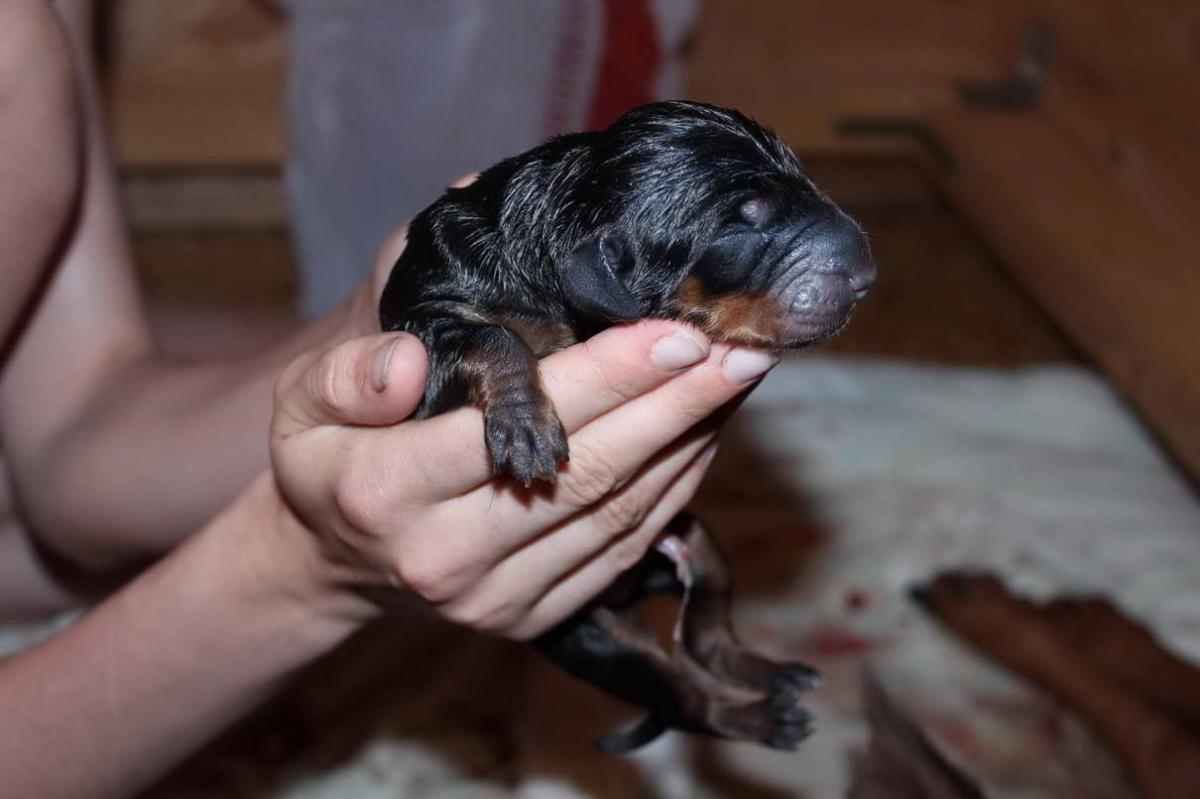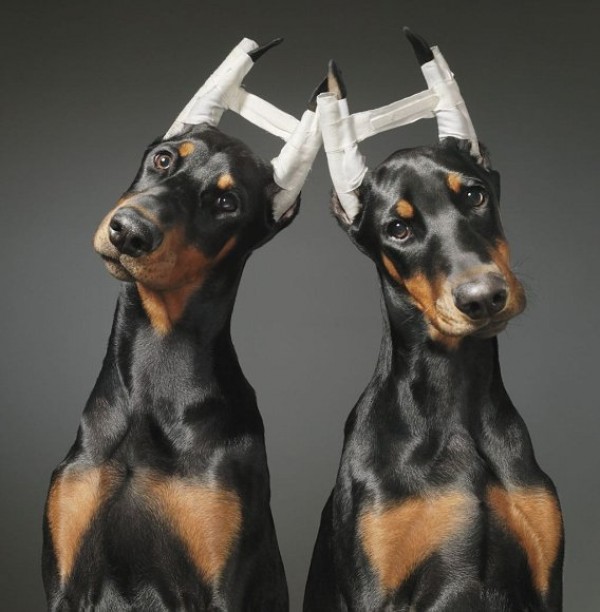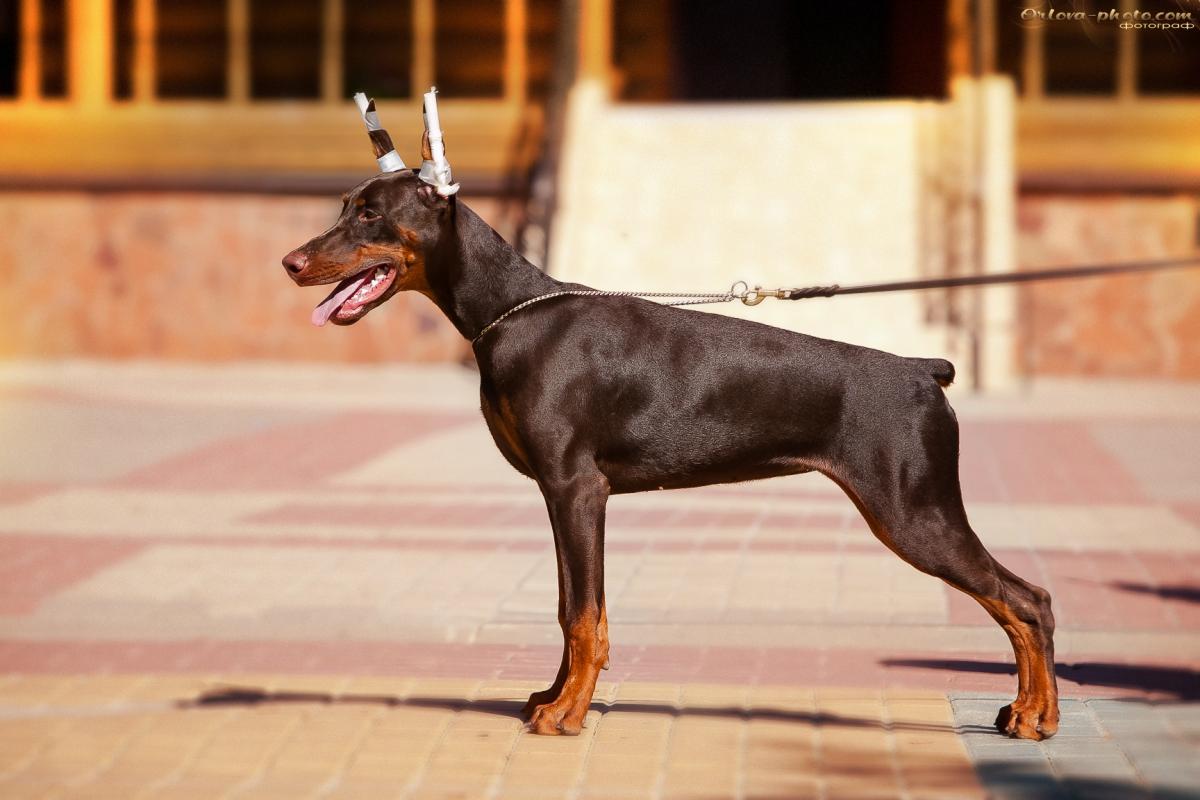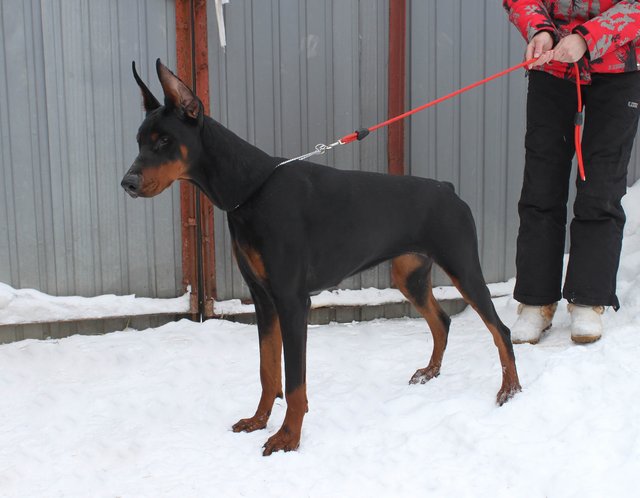Dobermans are both strong, powerful and elegant creatures. From a very young age they are completely devoted to their master, his family. The dog impresses not only with its appearance, but also amazing quick wits. Dobermanov is distinguished by a strong, independent nature, which may turn into difficulties in the initial stage of education and training. But if the animal takes time, attention, the puppy will grow up smart, active, but balanced and calm.
Monthly Development
Contents
Little Dobermans are born completely helpless – blind, deaf, have no teeth. They still do not know how to regulate heat transfer own body, why they must be kept in comfortable conditions – without drafts, sudden changes in temperature.
A newborn puppy weighs 4 00-6 00 g, its body length is 15 -20 cm. The baby already has a large head, legs, a dense and elastic body. The sizes of newborns depend on the size of the litter, heredity, gender.

1 month
In the first month, the development of the little Doberman is the most intense.
| Day of life | Development features |
| 1-5 | The animal is absolutely helpless – does not see, does not hear. Can just suck milk and crawl around in search of a mother. |
| 5-9 | Puppies begin to noticeably gain weight and size – increase almost before our eyes. |
| 10-15 | In babies eyes open. |
| 16-20 | The body’s heat control is being established, ears are opening. Puppy begins to respond to external stimuli. Dobermans actively crawl around the box, may try to stand on their paws. |
| 21-25 | First teeth erupt. Toddlers recognize mother, sisters and brothers, seeks to interact with them. |
| 25-30 | A monthly puppy is already striving to learn the world: crawls, learns walk and run. The heat regulation of the body is fully formed. Dog seeks to meet people like himself and others animals. |
One-month-old puppies can already reach 3.5-4 kg of weight, their length the body is almost doubled.

2 month
Doggie activity at maximum – he runs around the house, plays with comrades and people trying to eat independently. For development the baby is already not enough mother’s milk – is required lure.
2 month
Doggie activity at maximum – he runs around the house, plays with comrades and people trying to eat independently. For development the baby is already not enough mother’s milk – is required lure.
3 month
Usually at this age, puppies find a new home: they are capable of independently move and eat, understand what a walk is, home where you need to go to the toilet. Period of active development continues – when fully fed, they grow “like on yeast. ”

4 month
Little Dobermans have a transitional stage in development. AT they gain weight not so fast, but their little body begins stretch out, the dog becomes noticeably higher.
4 month
Little Dobermans have a transitional stage in development. AT they gain weight not so fast, but their little body begins stretch out, the dog becomes noticeably higher.
5 month
The puppy is no longer considered a baby – when translated into human he is already a teenager. Dobermans develop a skeletal skeleton, muscle corset. Five month old puppies are already successfully trained.

6 month
Six months of life is an important period in the formation of the psyche of a dog. Those the foundations of education that are laid down now will become decisive on her whole life. Character is formed, habits are formed. To the owner you need to pay maximum time to your pet: show the boundaries allowed, teach what is possible and what is not.
Active physical development slows down. In developed animals begin to manifest sexual instincts.

6 month
Six months of life is an important period in the formation of the psyche of a dog. Those the foundations of education that are laid down now will become decisive on her whole life. Character is formed, habits are formed. To the owner you need to pay maximum time to your pet: show the boundaries allowed, teach what is possible and what is not.
Active physical development slows down. In developed animals begin to manifest sexual instincts.

7 month
Outwardly, the Doberman teenager already resembles an adult dog. is he continues to gain in height and weight. This is already independent an animal that knows the simplest commands, understands who is the boss, where its territory, what bans are introduced by people.
8-9 month
A young animal is practically no different from older individuals. Doberman is active and full of energy. At this stage of his life, his character fully formed.
10-12 month
Height, weight gain, skeletal and muscular skeleton formation slows down. Doberman entered adulthood: needs in periodic active walks, training, balanced feeding according to age and parameters.

At 1-2 years old, the animal continues to develop: it may slightly put on height and weight. Doberman Pinscher gets stronger larger: chest, paws, head enlarged. Males become more muscular, stand out clearly against the background of females.
The increase in mass and height (at the withers) is demonstrated in table.
| Age (month) | Height (cm) | Weight, kg) | ||
| Males | Females | Males | Females | |
| 1 | 25-27 | 22-25 | 3,5-3,8 | 3.2-3.5 |
| 2 | 35-40 | 33-35 | 7.5-8.5 | 6.5-7 |
| 3 | 45-50 | 40-45 | 12-14 | 12-13 |
| 4 | 50-55 | 45-50 | 16.5-18.5 | 16-17 |
| 5 | 55-60 | 50-55 | 20,5-22 | 20-21 |
| 6 | 60-65 | 55-60 | 24-26 | 22-24 |
| 7 | 65-67 | 60-63 | 26-28 | 25-26 |
| 8-9 | 67-70 | 63-65 | 27-32 | 27-28 |
| 10-12 | 70-73 | 65-68 | 30-35 | 28-30 |
If the indicators are significantly different from those in the table, It will not be superfluous to show the puppy to the veterinarian.
Reasons for deviation from the norm
Deviation from standard puppy development may be caused by various factors:
- Improper nutrition. An unbalanced diet above all affects development. If the owner is difficult to comply with the ratio nutrients, vitamins, minerals, it can translate complex feed animal. In the diet of a young dog it is necessary a sufficient amount of carbohydrates (cereals, vegetables), lean meat and fish, offal. Human goodies, sweets are excluded.
- Diseases Underweight is triggered by genetic hormonal pathologies, sometimes allergic reactions. Reason Underweight can only be determined by an experienced veterinarian.
- Predisposition. Like humans, dogs can be born with propensity for fullness, small stature, low body weight. it is not a pathology, but an individual feature. For confirmation of genetic causes of inhibited development laboratory analysis is necessary.
- Climate, region of residence. Depending on environmental conditions puppies develop environments unevenly, as they depend on weight processes of thermoregulation. Therefore, born in the summer in a hot climate dogs develop more slowly than their northern, winter counterparts. Several the characteristics of the coat change: density, length.
To control the parameters, the correct measurement is important: use of a height meter, dynamic scales. The easiest way: the owner is weighed with a puppy in his arms, and then without him. Difference between the numbers is the weight of the dog.







